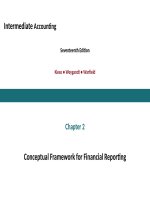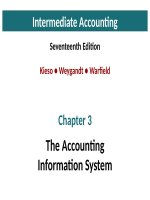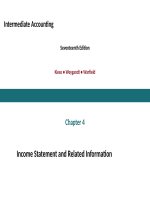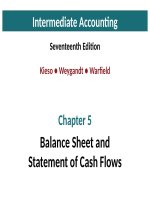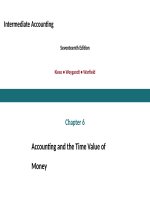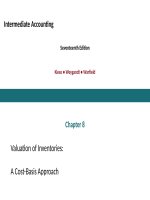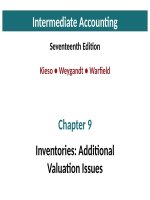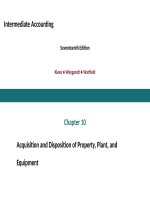Intermediate accounting 17e by kieso ch03
Bạn đang xem bản rút gọn của tài liệu. Xem và tải ngay bản đầy đủ của tài liệu tại đây (5.94 MB, 113 trang )
Intermediate Accounting
Seventeenth Edition
Kieso ● Weygandt ● Warfield
Chapter 3
The Accounting
Information
System
This slide deck contains animations. Please disable animations if
they cause issues with your device.
Learning Objectives
After studying this chapter, you should be able to:
1. Describe the basic accounting information system.
2. Record and summarize basic transactions.
3. Identify and prepare adjusting entries.
4. Prepare financial statements from the adjusted trial
balance and prepare closing entries.
5. Prepare financial statements for a merchandising
company.
Copyright ©2019 John Wiley & Sons, Inc.
2
Preview of Chapter 3 (1 of 5)
The Accounting Information System
Accounting Information System
• Basic terminology
• Debits and credits
• Accounting equation
• Financial statements and ownership structure
• The accounting cycle
Copyright ©2016 John Wiley & Sons, Inc
3
Preview of Chapter 3 (2 of 5)
The Accounting Information System
Record and Summarize Basic Transactions
• Journalizing
• Posting
• Chart of accounts
• Recording process illustrated
• Trial balance
Copyright ©2019 John Wiley & Sons, Inc.
4
Preview of Chapter 3 (3 of 5)
The Accounting Information System
Adjusting Entries
• Types of adjusting entries
• Deferrals
• Accruals
• Adjusted trial balance
Copyright ©2019 John Wiley & Sons, Inc.
5
Preview of Chapter 3 (4 of 5)
The Accounting Information System
Preparing Financial Statements
• Closing
• Post-closing trial balance
• Reversing entries
• Summary
Copyright ©2019 John Wiley & Sons, Inc.
6
Preview of Chapter 3 (5 of 5)
The Accounting Information System
Financial Statements for Merchandisers
• Income statement
• Retained earnings statement
• Balance sheet
• Closing entries
Copyright ©2019 John Wiley & Sons, Inc.
7
Learning Objective 1
Describe the Basic Accounting
Information System
Copyright ©2019 John Wiley & Sons, Inc.
8
Accounting Information System (1 of 4)
Accounting information system
• Collects and processes transaction data
• Disseminates financial information to interested
parties
Copyright ©2019 John Wiley & Sons, Inc.
9
Accounting Information System (2 of 4)
Helps management answer such questions as:
• How much and what kind of debt is outstanding?
• Were sales higher this period than last?
• What assets do we have?
• What were our cash inflows and outflows?
• Did we make a profit last period?
• Are any of our product lines or divisions operating at a
loss?
• Can we safely increase our dividends to stockholders?
• Is our rate of return on net assets increasing?
Copyright ©2019 John Wiley & Sons, Inc.
10
Accounting Information System (3 of 4)
Basic Terminology
• Event
• Journal
• Transaction
• Posting
• Account
• Trial Balance
• Real Account
• Adjusting Entries
• Nominal Account
• Financial Statements
• Ledger
• Closing Entries
Copyright ©2019 John Wiley & Sons, Inc.
11
Accounting Information System (4 of 4)
Debits and Credits
• An account shows the effect of transactions on a
given asset, liability, equity, revenue, or expense
account
• Double-entry accounting system (two-sided effect)
• Recording done by debiting at least one account and
crediting another
• Debits must equal Credits
Copyright ©2019 John Wiley & Sons, Inc.
12
Debits and Credits (1 of 5)
The Account
• Record of increases and decreases in a specific asset,
liability, stockholders’ equity, revenue, or expense
item.
• Debit = “Left”
• Credit = “Right”
An account can be
illustrated in a
T-account form.
Account Name
Debit
Credit
Copyright ©2019 John Wiley & Sons, Inc.
13
Debits and Credits (2 of 5)
If the sum of Debit entries are greater than the sum
of Credit entries, the account will have a debit
balance.
Transaction #1
Transaction #3
Balance
Account Name
Debit
Credit
$10,000
$3,000
8,000
$15,000
Copyright ©2019 John Wiley & Sons, Inc.
Transaction #2
14
Debits and Credits (3 of 5)
If the sum of Credit entries are greater than the sum
of Debit entries, the account will have a credit
balance.
Transaction #1
Balance
Account Name
Debit
Credit
$10,000
$3,000
8,000
$1,000
Copyright ©2019 John Wiley & Sons, Inc.
Transaction #2
Transaction #3
15
Debits and Credits
(4 of 5)
Normal Balance – Credit
Liability Accounts
Credit
Debit
- (decrease) + (increase)
Normal Balance – Debit
Asset Accounts
Credit
Debit
+ (increase) - (decrease)
Stockholders’ Equity Accounts
Credit
Debit
- (decrease) + (increase)
Expense Accounts
Credit
Debit
+ (increase) - (decrease)
Revenue Accounts
Credit
Debit
- (decrease) + (increase)
Copyright ©2019 John Wiley & Sons, Inc.
16
Debits and Credits (4 of 5)
Balance Sheet
Asset = Liability + Equity
Income Statement
Revenue - Expense =
Debit
Credit
Copyright ©2019 John Wiley & Sons, Inc.
34
The Accounting Equation
Relationship among the assets, liabilities and
stockholders’ equity accounts of a business:
The equation must be in balance after every transaction.
For every Debit there must be a Credit.
Copyright ©2019 John Wiley & Sons, Inc.
18
The Accounting Equation (1 of 4)
1. Owners invest $40,000 in exchange for common stock.
2. Disburse $600 cash for administrative wages.
Copyright ©2019 John Wiley & Sons, Inc.
19
The Accounting Equation (2 of 4)
3. Purchase office equipment priced at $5,200, giving a 10
percent promissory note in exchange.
4. Receive $4,000 cash for services performed.
Copyright ©2019 John Wiley & Sons, Inc.
20
The Accounting Equation (3 of 4)
5. Pay off a short-term liability of $7,000.
6. Declare a cash dividend of $5,000.
Copyright ©2019 John Wiley & Sons, Inc.
21
The Accounting Equation (4 of 4)
7. Convert a long-term liability of $80,000 into common stock.
8. Pay cash of $16,000 for a delivery van.
Copyright ©2019 John Wiley & Sons, Inc.
22
Financial Statements and Ownership
Structure
• Stockholders’ equity section of the balance sheet
reports common stock and retained earnings
• Income statement reports revenues and expenses
• Retained earnings statement reports net
income/loss and dividends
• Because dividends, revenues, and expenses are
transferred to retained earnings at the end of the
period, a change in any one of these three items
affects stockholders’ equity
Copyright ©2019 John Wiley & Sons, Inc.
23
Financial
Statements
Copyright ©2019 John Wiley & Sons, Inc.
24
Ownership Structure
Effects of Transactions
on Equity Accounts
Ownership Structure
Proprietorships and
Partnerships
Corporations
Transaction Affecting
Owners’ or
Stockholder’ Equity
Investment by owner(s)
Impact on
Owners’ or
Stockholder’
Equity
Increase
Nominal
(Temporary)
Accounts
Revenues recognized
Expenses incurred
Withdrawal by owner(s)
Increase
Decrease
Decrease
Revenue
Expense
Drawings
Real
(Permanent)
Accounts
Capital
Capital
Copyright ©2019 John Wiley & Sons, Inc.
Nominal
(Temporary)
Accounts
Revenue
Expense
Dividends
Real
(Permanent)
Accounts
Common
Stock and
related
accounts
Retained
Earnings
25
